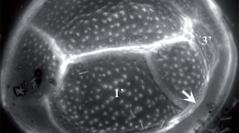

 Cryptogamie, Algologie
36 (1) - Pages 101-119
Cryptogamie, Algologie
36 (1) - Pages 101-119The toxic epi-benthic dinoflagellate Ostreopsis is distributed worldwide in coral reef ecosystems and temperate regions. There are nine species described to date based on morphological features. Some of them have been proved to be producers of palytoxin-like compounds, representing a threat to coastal marine organisms and human health. The taxonomy of the genus is currently under revision due to morphological similarities among species. The present study aims to provide additional information on morphology, 5.8S and ITS data and toxin content from thirty three strains isolated along the west coast of Reunion Island, in the Indian Ocean. Two morphotypes, non overlapping in size, were distinguishable: the small morphotype (DV = 53.5 ± 6.9 µm; W = 37.7 ± 5.6 µm) with a typical tear-drop shape and the large morphotype (DV = 103.9 ± 5.1 µm; W = 85.3 ± 6.9 µm) with a rounded shape. Phylogenetic analysis revealed the presence of three genotypes. Within the small morphotype, two different species were identifided, O. cf. ovata and a cryptic species not previously characterized. The larger cells constituted a genetically homogeneous clade. Nucleotide divergence between this species and the one qualified by Sato et al., 2011 of Ostreopsis sp. 5 was relatively low (p < 0.088) and those two strains are likely to be the same species. Haemolytic analysis resulted in no palytoxin-like activity in any of the three species.